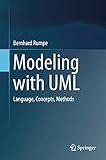Modeling with UML [electronic resource] : Language, Concepts, Methods / by Bernhard Rumpe.
By: Rumpe, Bernhard [author.].
Contributor(s): SpringerLink (Online service).
Material type: BookPublisher: Cham : Springer International Publishing : Imprint: Springer, 2016Description: XIV, 281 p. 175 illus., 3 illus. in color. online resource.Content type: text Media type: computer Carrier type: online resourceISBN: 9783319339337.Subject(s): Computer science | Management information systems | Software engineering | Computer Science | Software Engineering | Software Management | Management of Computing and Information SystemsAdditional physical formats: Printed edition:: No titleDDC classification: 005.1 Online resources: Click here to access online
BookPublisher: Cham : Springer International Publishing : Imprint: Springer, 2016Description: XIV, 281 p. 175 illus., 3 illus. in color. online resource.Content type: text Media type: computer Carrier type: online resourceISBN: 9783319339337.Subject(s): Computer science | Management information systems | Software engineering | Computer Science | Software Engineering | Software Management | Management of Computing and Information SystemsAdditional physical formats: Printed edition:: No titleDDC classification: 005.1 Online resources: Click here to access online Introduction -- Class Diagrams -- Object Constraint Language -- Object Diagrams -- State charts -- Sequence Diagrams -- A Language Representation with Syntax Class Diagrams -- B Java -- C The Syntax of the UML/P -- D Sample application: Internet-based Auction System -- References.
This book presents a variant of UML that is especially suitable for agile development of high-quality software. It adjusts the language UML profile, called UML/P, for optimal assistance for the design, implementation, and agile evolution to facilitate its use especially in agile, yet model based development methods for data intensive or control driven systems. After a general introduction to UML and the choices made in the development of UML/P in Chapter 1, Chapter 2 includes a definition of the language elements of class diagrams and their forms of use as views and representations. Next, Chapter 3 introduces the design and semantic facets of the Object Constraint Language (OCL), which is conceptually improved and syntactically adjusted to Java for better comfort. Subsequently, Chapter 4 introduces object diagrams as an independent, exemplary notation in UML/P, and Chapter 5 offers a detailed introduction to UML/P Statecharts. Lastly, Chapter 6 presents a simplified form of sequence diagrams for exemplary descriptions of object interactions. For completeness, appendixes A-C describe the full syntax of UML/P, and appendix D explains a sample application from the E-commerce domain, which is used in all chapters. This book is ideal for introductory courses for students and practitioners alike. .


There are no comments for this item.